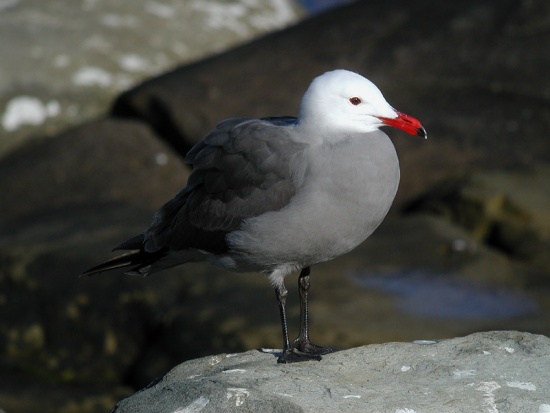- Larus heermanni
Identification
43–49 cm (17-19¼ in); a medium-sized gull
- Gray body
- Blackish-grey wings and tail with white edges
- Red bill with black tip
- White head during breeding
- Gray head during non-breeding
Immature
Resembles non-breeding adults but are darker and browner, and the bill is flesh-colored or pink until the second winter.
Distribution
The west coast of North America. Breeds only on islands off the west coast of Mexico, but a common non-breeding visitor to the west coast of California in the United States, and in smaller numbers north through Oregon and Washington to British Columbia in Canada.
Vagrant in Alaska and Guatemala.
Taxonomy
This is a monotypic species[1]..
Habitat
Shores or well out to sea, rarely inland, but occurs regularly at Salton Sea in California.
Status
Classified as Near Threatened in the 2008 IUCN Red List.2 The breeding range is severely restricted; 90% of the population breeds on a single Mexican island, Isla Rasa.
Behavior
Breeding
Nests colonially on the ground, like many gulls. It lays two or three eggs, grayish buff to buff with gray and brown markings.
Diet
Feeds on a wide range of seafood (small fish, shellfish, squid, etc.), often taken by kleptoparasitism from other seabirds (most often Brown Pelicans) and sealions.
References
- Clements, J. F., T. S. Schulenberg, M. J. Iliff, D. Roberson, T. A. Fredericks, B. L. Sullivan, and C. L. Wood. 2017. The eBird/Clements checklist of birds of the world: v2017, with updates to August 2017. Downloaded from http://www.birds.cornell.edu/clementschecklist/download/
- BirdLife International (2008) Species factsheet: Larus heermanni. Downloaded from http://www.birdlife.org on 12/9/2008.
- Handbook of the Birds of the World Alive (retrieved December 2016)
Recommended Citation
- BirdForum Opus contributors. (2025) Heermann's Gull. In: BirdForum, the forum for wild birds and birding. Retrieved 11 May 2025 from https://www.birdforum.net/opus/Heermann%27s_Gull






